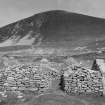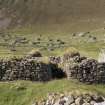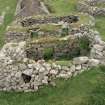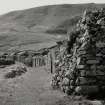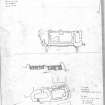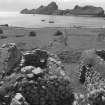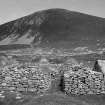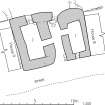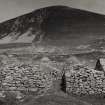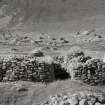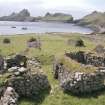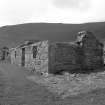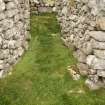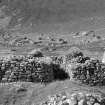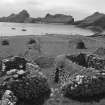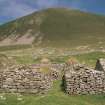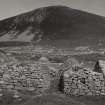Following the launch of trove.scot in February 2025 we are now planning the retiral of some of our webservices. Canmore will be switched off on 24th June 2025. Information about the closure can be found on the HES website: Retiral of HES web services | Historic Environment Scotland
St Kilda, Hirta, Village Bay, Blackhouse I
Blackhouse (19th Century)
Site Name St Kilda, Hirta, Village Bay, Blackhouse I
Classification Blackhouse (19th Century)
Canmore ID 300973
Site Number NF19NW 21.46
NGR NF 10100 99358
Datum OSGB36 - NGR
Permalink http://canmore.org.uk/site/300973
- Council Western Isles
- Parish Harris
- Former Region Western Isles Islands Area
- Former District Western Isles
- Former County Inverness-shire
NF19NW 21.46 10100 99358
Adjacent to the W gable-wall of House 8 (see NF19NW 21.04) is Blackhouse I, a drystone structure built end-on to the street. Internally, it measures 4.11m by 1.85m transversely within walls varying between 0.38m and 1.22m in thickness. There is a very large boulder in the NE corner. The walls, which have vertical inner and outer faces and rounded external N angles, rise to a height of 1.65m at the sides and up to 2.49m at the gables; because the building is set in to the slope, the N gable-wall is only 1.3m above ground level externally. The E side-wall was sagging in 1983, and has since been rebuilt. The entrance is towards the N end of the W side-wall, and is spanned by two slab lintels, the inner lintel still bearing a sheet of roofing zinc. Towards the W end of the S gable-wall is a small window.
Stell and Harman 1988
Publication Account (1988)
NF19NW 21.04 10107 99359
The ruinous shell of house 8, which was inhabited by the MacDonald family, exhibits evidence of the features and the standard layout on which, with minor variations, all houses of the 1860s were built. They generally contained a kitchen and room, flanking a central entrance-lobby and closet. Gabled and built of lime-mortared stone, some of which has been dressed, the house is rectangular on plan, measuring 8.92m by 3.96m internally. It has a symetrical three-bay S or street frontage, comprising a central doorway and a pair of window-openings. Parts of a footings-course are visible along the front and E gable-wall, and at the rear of the house there is a revetted drainage channel which forms the S edge of a walled garden.
Internally, the entrance-lobby has had a concrete floor, and the NE-corner of the building is also concrete-floored. There are surviving patches of wall plaster and at the W end of the N side-wall the plaster bears traces of a pink wash. There is a fireplace in each gable-wall; the E fireplace has an iron bar built into the ingoing and incorporates a large slab hearthstone. There is a mural cupboard in the SE-corner. Adjacent to the W gable-wall is Blackhouse I, a drystone structure built end-on to the street. Internally, it measures 4.11m by 1.85m transversely within walls varying between 0.38m and 1.22m in thickness. There is a very large boulder in the NE corner. The walls, which have vertical inner and outer faces and rounded external N angles, rise to a height of 1.65m at the sides and up to 2.49m at the gables; because the building is set in to the slope, the N gable-wall is only 1.3m above ground level externally. The E side-wall was sagging in 1983, and has since been rebuilt. The entrance is towards the N end of the W side-wall, and is spanned by two slab lintels, the inner lintel still bearing a sheet of roofing zinc. Towards the W end of the S gable-wall is a small window.
At the E end of House 8 archaeological excavations carried out by the University of Durham in 1986, revealed the fragmentary remains of a blackhouse of the 1830s partly underlying the present one. The blackhouse was originally about 10m in length overall from N to S by about 6.5m transversely. Traces of a stone-lined hearth in the clay floor of the N half of the building were uncovered, and the footings of a cross-wall divided off the area of the former dwelling house from the byre at the slightly lower S end.
G P Stell and M Harman 1988.





















































